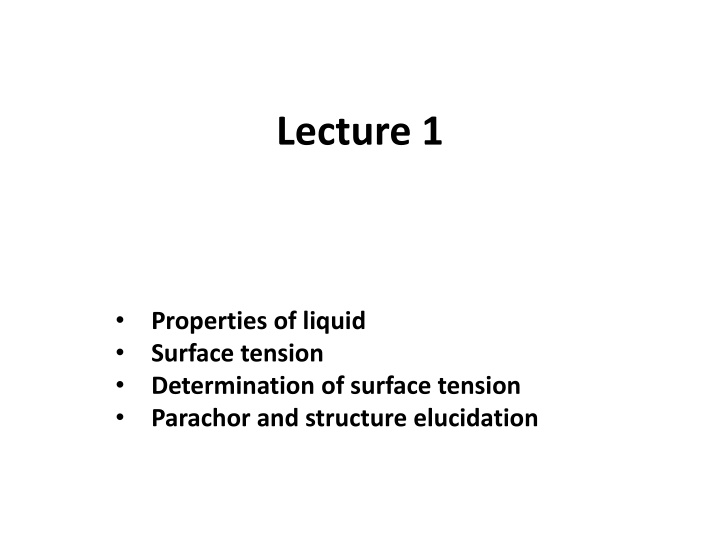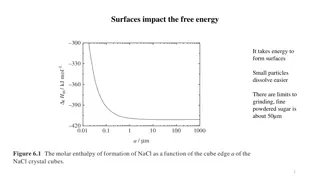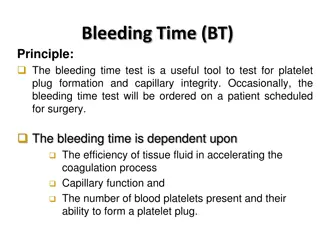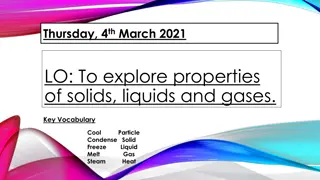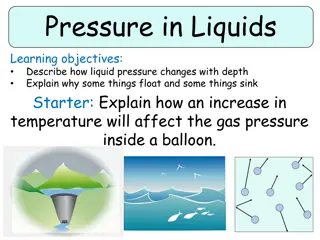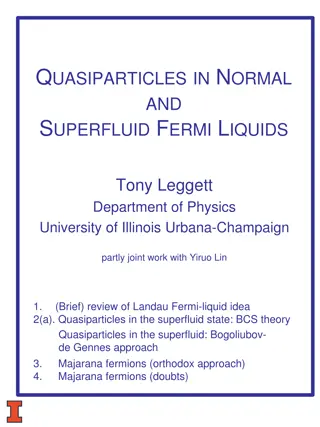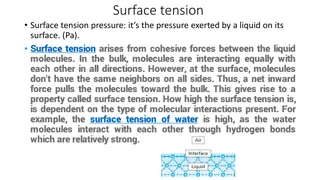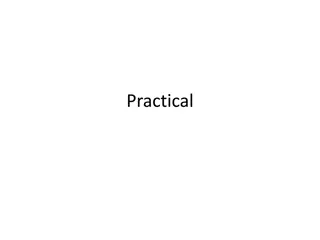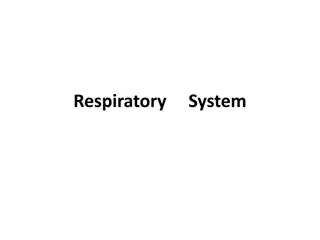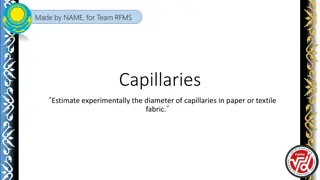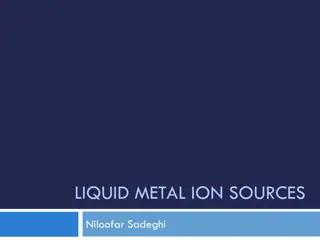Properties of Liquids: Surface Tension & Capillary Action
Explore the properties of liquids, including surface tension and capillary action. Learn how liquids differ from solids and gases, the definition and measurement of surface tension, and the role of contact angle in capillary action.
Download Presentation

Please find below an Image/Link to download the presentation.
The content on the website is provided AS IS for your information and personal use only. It may not be sold, licensed, or shared on other websites without obtaining consent from the author.If you encounter any issues during the download, it is possible that the publisher has removed the file from their server.
You are allowed to download the files provided on this website for personal or commercial use, subject to the condition that they are used lawfully. All files are the property of their respective owners.
The content on the website is provided AS IS for your information and personal use only. It may not be sold, licensed, or shared on other websites without obtaining consent from the author.
E N D
Presentation Transcript
Lecture 1 Properties of liquid Surface tension Determination of surface tension Parachor and structure elucidation
Properties of liquids Liquids state is intermediate between solid and liquid. Liquids do not have definite shape. Molecules of liquids have intermediate order of cohesive forces. Liquids resembles solids in terms of compressibility and density. In liquids there is little space between molecules.
Figure 1: Relative spacing between molecules in solids , lquids and gases.
The compactness and cohesion observed in liquids are like solids and random motion of molecules is like that occur in gases. Q: write down the properties of liquids?
Surface tension Surface tension is another property of the liquid related to intermolecular forces.
Surface tension is defined as force in newton acting at right angles along the surface of a liquid one meter in length . It is represented by (gamma). Units Dynes cm-1 or ergs cm -2 Nm-1 or Jm -2 Do you know? 1 dyne cm-1 = 10-3 Nm -1
Capillary Action Which liquid wets the surface of the solid, depends upon the interaction between the liquid molecules and solid surface. Contact angle ( ) the contact angle is angle between the tangent to the liquid surface at the point of contact and the solid surface inside the liquid
Its values ranges between 0 to 180. If value is less than 90 , the liquid wets the surface of the solid. If value is greater than 90 ,the liquid does not wet the surface.
Measurement of Surface Tension Capillary Rise method: The rise or fall of liquid in the capillary tube depends upon the surface tension.
r =radius of capillary tube h = height of liquid column = Surface tension Fu = Fd The force due to surface tension is acting at the angle . The upward force is equal to the vertical component of the surface tension, i.e. Cos times circumference
Fu = 2r. Cos --------- (1) The downward force is given by: Fd = weight of the liquid column Fd = mg = Vdg---------- (2) Volume of the liquid in the column is V= r2h At height h Fu= Fd So, 2 r. Cos = r2hdg Now simplify: = rhdg/2Cos If , = 0 Then, = rhdg/2
Numerical The radius of a capillary tube is 1.05 x 10-4 m. Density of liquid is 0.80 g/cm3 rises to a height of 6.25 x 10-2 m. calculate surface tension. ( =0 ).
The Drop Weight Method In this method the liquid whose surface tension is to be measured is allowed to pass through a capillary tube held vertically. The liquid that comes out of the capillary tube assumes a spherical shape and has some definite weight. When the wt of drop becomes equal to surface tension, acting along the circumference of the tube, it falls down.
There fore, 2 r = W = mg = Vdg----1 This method is generally used for comparison. The instrument used to determine surface tension is called stalagmometer .
Stalagmometer is a bulbed capillary tube, it is filled upto mark A with the liquid.the liquid is then allowed to fall slowly, in the form of dropswhich are collected in the weighing bottle, the rate at which drops fall is adjusted in such a way, that every drop falls after 3 sec. If W1 and W2 are the weights of 10 drops of two liquids , and 1 and 2 are their surface tension then, 1 / 2 = W1 / W2 -------(1)
It is more convenient to determine the number of drops of fixed volume of liquid than to determine weight. If n1 and n2 are the number of drops of two liquids and d1 and d2 are their densities. Then average weight of liquid drops is W1 = m1g/n1= Vd1g/n1 W2= Vd2g/n2 putting the values of W1 and W2 in the following equation: 1/ 2 = W1 / W2 -------(1) We get 1/ 2 = d1 n2 /n1d2
Numerical At 293 K, 10-2 dm3 of water formed 29 drops, and the same volume of other liquid formed 86 drops in the same stalagmometer. Density of organic liquid is 0.7 g/cm3 and water is 1 g/cm3. The surface tension of water is 7.2 x 10-2 Nm-1.determine the surface tension of organic liquid?
Surface Tension and Chemical Constitution-Parachor The empirical relationship between surface tension and density for normal liquids is given by D.B Macleod in 1923: 1/4 / D-d = C Where, D = Density of liquid d = Density of vapours C= Constant, is independent of temperature for non-associated liquids and increases for associated liquid, with rise in temperature.
Sudgen (1924) multiplied the Macleod equation with molecular mass and obtained a new constant called Parachor. M 1/4 / D-d = MC = [P] At temperature below critical temperature D>>d, So M 1/4 / D = [P] M/D is molar volume (Vm)of liquid,if surface tension = 1, then [P]= Vm So, Parachor is defined as the molar volume of the liquid at a temperature where its surface tension is unity. Parachor is both additive and constitutive property, it value is expressed as two sets of constants.
Numerical The surface tension of benzene is 29.2 dynes / cm, its density is 0.88 g/cm3.Calculate its parachor value?
Application of Parachor value to elucidate the structure Structure of benzene To calculate the parachor value of benzene 6C = 4X 4.8= 28.8 6H= 6X 17.1= 102.6 3 Double bonds = 3x 23.3 = 69.6 1 ring =1x 6.1 = 6.1 Total : 207.1 Observed parachor value = 206.4 So, ..
Structure of Quinone [P]= 236.1 [P]= 219.0 Observed value = 236.8
Position of substituent doesnot change the parachor value. The observed value of o-chlorotoluene is 280.8 and for p-chlorotoluene is 283.6 and theoretical value for both isomers is same that is 283.3.
Applications of Surface tension Cleansing action of soap Tooth paste Nasal jellies Mouth washes Look for more ..
